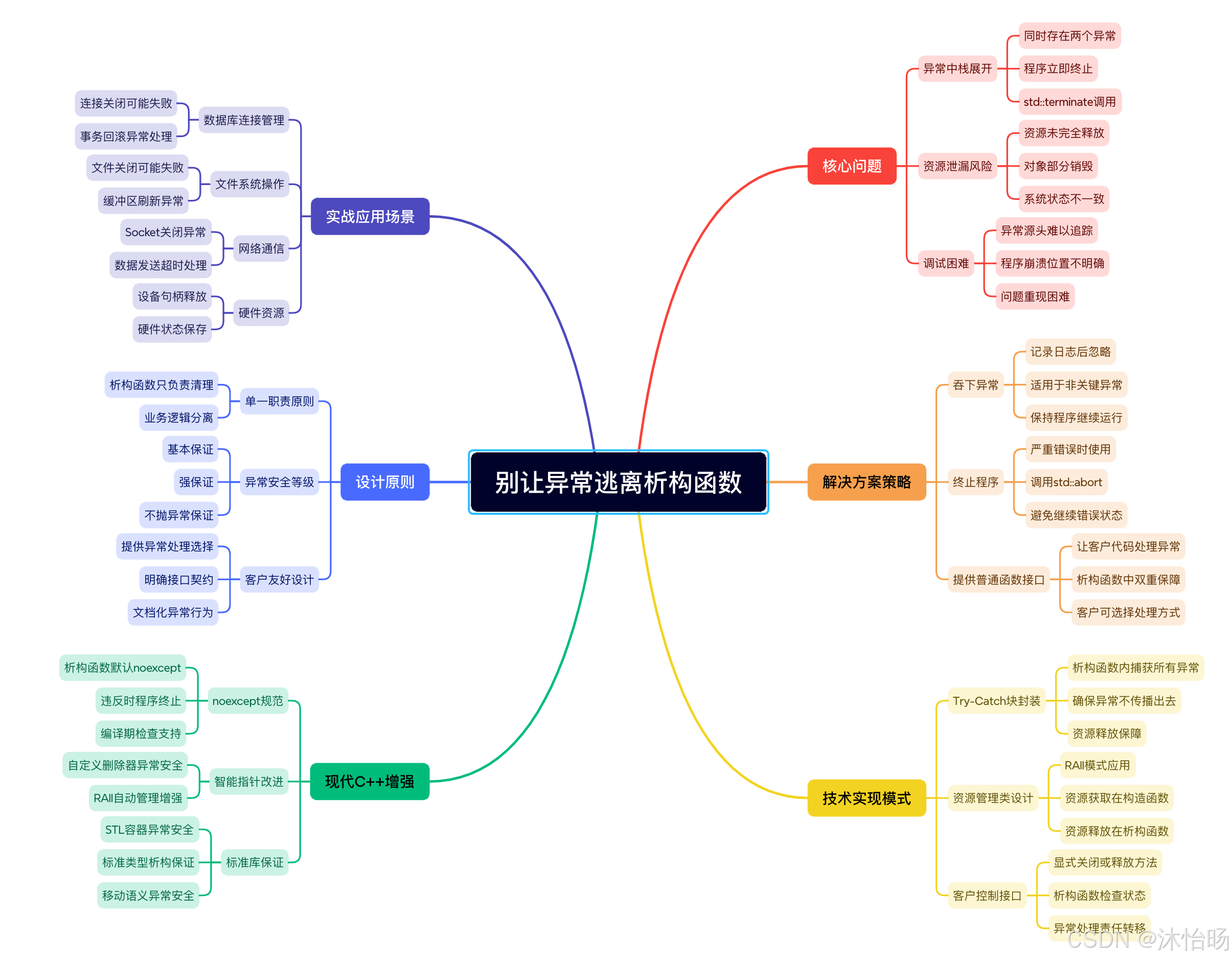【穿越Effective C++】条款8:别让异常逃离析构函数——C++异常安全的关键支柱
这个条款揭示了C++异常处理中最重要的规则之一:析构函数绝不能抛出异常。这是构建异常安全代码的基石,理解这一点对于开发健壮的C++系统至关重要。
思维导图:析构函数异常安全的完整体系

深入解析:析构函数异常的核心危险
1. 双重异常灾难——程序终止的必然性
危险的析构函数设计:
class DangerousResource {
private:FILE* file_handle_;std::vector<int> data_cache_;public:DangerousResource(const std::string& filename) : file_handle_(fopen(filename.c_str(), "w")) {if (!file_handle_) {throw std::runtime_error("无法打开文件");}data_cache_.resize(1000); // 分配资源}~DangerousResource() {// 危险!可能抛出异常if (fclose(file_handle_) != 0) {throw std::runtime_error("文件关闭失败"); // 异常逃离析构函数!}// 更多可能失败的操作data_cache_.clear(); // 通常不会失败,但理论上可能}void writeData(const std::string& data) {if (fprintf(file_handle_, "%s", data.c_str()) < 0) {throw std::runtime_error("写入失败");}}
};void demonstrate_catastrophe() {try {DangerousResource resource("data.txt");resource.writeData("重要数据");// 模拟某些操作可能抛出异常throw std::logic_error("业务逻辑异常");} catch (const std::exception& e) {std::cout << "捕获异常: " << e.what() << std::endl;// 当resource离开作用域时,析构函数被调用// 如果析构函数抛出异常,程序会调用std::terminate()!}// 程序可能在这里终止!
}
C++标准规定: 如果栈展开过程中析构函数抛出异常,且这个异常没有被析构函数自身捕获,程序将调用std::terminate()立即终止。
2. 实际问题重现
class ProblematicConnection {
private:network_socket_t socket_;public:ProblematicConnection(const char* address) {socket_ = network_connect(address); // 可能失败if (!socket_) {throw std::runtime_error("连接失败");}}~ProblematicConnection() {// 危险:network_close可能失败并抛出异常if (network_close(socket_) != 0) {throw network_exception("关闭连接失败"); // 异常逃离!}}
};void real_world_scenario() {try {ProblematicConnection conn("192.168.1.100");// 业务操作...process_data(conn);// 假设这里抛出异常throw data_processing_error("数据处理失败");} catch (const data_processing_error& e) {// 处理业务异常log_error(e.what());// 但此时conn的析构函数被调用// 如果network_close失败,程序立即终止!}
}
解决方案:三种安全策略
1. 策略一:吞下异常(记录并继续)
class SafeResource_Swallow {
private:FILE* file_handle_;std::string resource_name_;public:SafeResource_Swallow(const std::string& filename) : file_handle_(fopen(filename.c_str(), "w")), resource_name_(filename) {if (!file_handle_) {throw std::runtime_error("无法打开文件: " + filename);}}~SafeResource_Swallow() noexcept { // C++11: 明确声明不抛异常try {if (file_handle_) {if (fclose(file_handle_) != 0) {// 吞下异常,但记录日志std::cerr << "警告: 文件关闭失败: " << resource_name_ << ",错误: " << strerror(errno) << std::endl;// 不抛出异常!}}} catch (...) {// 捕获所有异常,确保没有异常逃离std::cerr << "严重: 析构函数中发生未知异常,已吞下" << std::endl;}}void writeData(const std::string& data) {if (fprintf(file_handle_, "%s", data.c_str()) < 0) {throw std::runtime_error("写入失败");}}// 禁用拷贝SafeResource_Swallow(const SafeResource_Swallow&) = delete;SafeResource_Swallow& operator=(const SafeResource_Swallow&) = delete;
};
2. 策略二:终止程序(严重错误时)
class CriticalResource_Abort {
private:void* system_handle_;bool resource_critical_;public:CriticalResource_Abort() : system_handle_(acquire_system_resource()),resource_critical_(true) {if (!system_handle_) {throw std::runtime_error("无法获取关键系统资源");}}~CriticalResource_Abort() noexcept {try {if (resource_critical_ && system_handle_) {if (release_system_resource(system_handle_) != SUCCESS) {// 关键资源释放失败,程序状态可能损坏std::cerr << "致命错误: 关键系统资源释放失败!" << std::endl;std::abort(); // 立即终止程序}resource_critical_ = false;system_handle_ = nullptr;}} catch (...) {std::cerr << "致命错误: 析构函数中发生未知异常" << std::endl;std::abort();}}void markNonCritical() noexcept {resource_critical_ = false;}
};
3. 策略三:提供客户控制接口(最佳实践)
class ClientControlledResource {
private:FILE* file_handle_;std::string filename_;bool is_closed_;public:explicit ClientControlledResource(const std::string& filename): file_handle_(fopen(filename.c_str(), "w")),filename_(filename),is_closed_(false) {if (!file_handle_) {throw std::runtime_error("无法打开文件: " + filename);}}// 客户显式关闭接口,可以处理异常void close() {if (is_closed_) return;if (file_handle_) {if (fclose(file_handle_) != 0) {throw std::runtime_error("关闭文件失败: " + filename_);}file_handle_ = nullptr;is_closed_ = true;}}~ClientControlledResource() noexcept {try {if (!is_closed_ && file_handle_) {// 双重保障:如果客户没有关闭,我们尝试关闭// 但吞下任何异常if (fclose(file_handle_) != 0) {std::cerr << "警告: 析构函数中文件关闭失败: " << filename_ << std::endl;}}} catch (...) {std::cerr << "警告: 析构函数中文件关闭发生异常: " << filename_ << std::endl;}}void writeData(const std::string& data) {if (is_closed_) {throw std::logic_error("文件已关闭");}if (fprintf(file_handle_, "%s", data.c_str()) < 0) {throw std::runtime_error("写入失败");}}// 禁用拷贝ClientControlledResource(const ClientControlledResource&) = delete;ClientControlledResource& operator=(const ClientControlledResource&) = delete;
};// 客户使用方式
void client_usage_example() {ClientControlledResource resource("important_data.txt");try {resource.writeData("关键业务数据");// 业务逻辑...perform_critical_operation();// 客户显式关闭,可以处理异常resource.close(); // 如果失败会抛出异常} catch (const std::exception& e) {std::cerr << "操作失败: " << e.what() << std::endl;// resource的析构函数会确保资源释放,但吞下异常}
}
现代C++的增强特性
1. noexcept规范与编译期检查
class ModernResource {
private:std::unique_ptr<int[]> data_;std::atomic<bool> cleanup_done_{false};public:ModernResource(size_t size) : data_(std::make_unique<int[]>(size)) {}// C++11: 明确声明析构函数不抛异常~ModernResource() noexcept {// 编译器会检查确保没有异常逃离perform_cleanup();}void perform_cleanup() noexcept {if (!cleanup_done_.exchange(true)) {// 所有可能失败的操作都必须处理异常try {cleanup_internal();} catch (...) {// 必须捕获所有异常log_cleanup_failure();}}}private:void cleanup_internal() {// 即使这里可能抛出异常...if (data_) {data_.reset(); // unique_ptr的reset是noexcept的}}void log_cleanup_failure() const noexcept {std::cerr << "资源清理失败,但程序继续运行" << std::endl;}
};// C++17: 条件性noexcept
template<typename T>
class GenericContainer {
private:std::vector<T> elements_;public:// 析构函数条件性noexcept:只有当T的析构是noexcept时才是noexcept~GenericContainer() noexcept(std::is_nothrow_destructible_v<T>) {// 实现...}
};
2. RAII与智能指针的现代应用
class AdvancedDatabaseTransaction {
private:struct DatabaseHandle {void* native_handle;DatabaseHandle(void* handle) : native_handle(handle) {}~DatabaseHandle() noexcept {if (native_handle) {try {if (database_release(native_handle) != DB_SUCCESS) {// 记录但不抛出log_database_error("数据库句柄释放失败");}} catch (...) {log_database_error("数据库释放过程中发生异常");}native_handle = nullptr;}}// 禁用拷贝,允许移动DatabaseHandle(const DatabaseHandle&) = delete;DatabaseHandle& operator=(const DatabaseHandle&) = delete;DatabaseHandle(DatabaseHandle&& other) noexcept : native_handle(other.native_handle) {other.native_handle = nullptr;}DatabaseHandle& operator=(DatabaseHandle&& other) noexcept {if (this != &other) {if (native_handle) {database_release(native_handle);}native_handle = other.native_handle;other.native_handle = nullptr;}return *this;}};DatabaseHandle db_handle_;bool transaction_active_;public:AdvancedDatabaseTransaction(const std::string& connection_string): db_handle_(database_connect(connection_string.c_str())),transaction_active_(false) {if (!db_handle_.native_handle) {throw std::runtime_error("数据库连接失败");}}void beginTransaction() {if (database_begin_transaction(db_handle_.native_handle) != DB_SUCCESS) {throw std::runtime_error("事务开始失败");}transaction_active_ = true;}void commit() {if (!transaction_active_) return;if (database_commit(db_handle_.native_handle) != DB_SUCCESS) {throw std::runtime_error("事务提交失败");}transaction_active_ = false;}void rollback() noexcept {if (!transaction_active_) return;try {if (database_rollback(db_handle_.native_handle) != DB_SUCCESS) {log_database_error("事务回滚失败");}transaction_active_ = false;} catch (...) {log_database_error("事务回滚过程中发生异常");}}~AdvancedDatabaseTransaction() noexcept {rollback(); // 确保在析构时回滚未完成的事务}// 禁用拷贝AdvancedDatabaseTransaction(const AdvancedDatabaseTransaction&) = delete;AdvancedDatabaseTransaction& operator=(const AdvancedDatabaseTransaction&) = delete;
};
实战案例:复杂系统的异常安全设计
案例1:分布式事务管理器
class DistributedTransaction {
private:std::vector<std::unique_ptr<class Participant>> participants_;bool prepared_{false};bool committed_{false};public:void addParticipant(std::unique_ptr<Participant> participant) {participants_.push_back(std::move(participant));}// 两阶段提交:准备阶段void prepare() {for (auto& participant : participants_) {participant->prepare();}prepared_ = true;}// 两阶段提交:提交阶段void commit() {if (!prepared_) {throw std::logic_error("事务未准备");}try {for (auto& participant : participants_) {participant->commit();}committed_ = true;} catch (...) {// 提交失败,必须回滚rollback();throw;}}// 回滚操作 - 必须保证不抛异常void rollback() noexcept {try {for (auto& participant : participants_) {try {participant->rollback();} catch (const std::exception& e) {// 单个参与者回滚失败不影响其他参与者log_rollback_failure(participant->getId(), e.what());}}} catch (...) {// 确保没有异常逃离log_critical_rollback_failure();}prepared_ = false;}~DistributedTransaction() noexcept {if (prepared_ && !committed_) {// 如果准备但未提交,必须回滚rollback();}}
};class Participant {
public:virtual ~Participant() = default;virtual void prepare() = 0; // 可能抛出异常virtual void commit() = 0; // 可能抛出异常virtual void rollback() noexcept = 0; // 必须不抛异常!virtual std::string getId() const = 0;
};
案例2:网络连接池
class ConnectionPool {
private:struct PooledConnection {std::unique_ptr<NetworkConnection> connection;std::chrono::steady_clock::time_point last_used;bool in_use{false};~PooledConnection() noexcept {try {if (connection) {connection->close(); // 假设close()可能失败}} catch (...) {// 吞下异常,但记录日志log_connection_cleanup_failure();}}};std::vector<PooledConnection> connections_;std::mutex pool_mutex_;public:std::unique_ptr<NetworkConnection> acquireConnection() {std::lock_guard<std::mutex> lock(pool_mutex_);for (auto& pooled_conn : connections_) {if (!pooled_conn.in_use) {pooled_conn.in_use = true;pooled_conn.last_used = std::chrono::steady_clock::now();// 返回包装器,确保连接正确返回池中return std::unique_ptr<NetworkConnection>(pooled_conn.connection.get(),[this, &pooled_conn](NetworkConnection*) {releaseConnection(pooled_conn);});}}throw std::runtime_error("无可用连接");}private:void releaseConnection(PooledConnection& pooled_conn) noexcept {try {std::lock_guard<std::mutex> lock(pool_mutex_);pooled_conn.in_use = false;pooled_conn.last_used = std::chrono::steady_clock::now();} catch (...) {// 互斥锁操作失败是严重错误,但析构函数不能抛出log_critical_pool_error();}}~ConnectionPool() noexcept {try {cleanupIdleConnections();} catch (...) {log_pool_cleanup_failure();}}void cleanupIdleConnections() noexcept {std::lock_guard<std::mutex> lock(pool_mutex_);auto now = std::chrono::steady_clock::now();for (auto& conn : connections_) {if (!conn.in_use) {auto idle_time = now - conn.last_used;if (idle_time > std::chrono::minutes(30)) {try {conn.connection.reset(); // 关闭连接} catch (...) {log_connection_cleanup_failure();}}}}}
};
关键洞见与行动指南
必须遵守的核心规则:
- 析构函数绝对不抛出异常:这是C++异常安全的铁律
- 资源释放操作必须异常安全:确保资源在任何情况下都能正确释放
- 提供客户控制接口:让客户代码有机会处理可能失败的清理操作
- 记录但不传播:在析构函数中记录错误,但继续执行
现代C++开发建议:
- 使用noexcept规范:明确声明析构函数不抛异常
- 智能指针管理资源:利用RAII自动管理生命周期
- try-catch块封装:在析构函数内捕获所有异常
- 单元测试验证:测试析构函数在各种异常场景下的行为
设计原则总结:
- 单一职责:析构函数只负责资源释放,不包含复杂业务逻辑
- 客户友好:提供显式的清理方法,让客户处理异常
- 防御性编程:假设任何操作都可能失败,做好异常处理准备
- 可观测性:即使吞下异常,也要记录足够的调试信息
需要警惕的陷阱:
- 间接异常:调用的函数可能抛出意想不到的异常
- 标准库保证:了解不同STL操作的异常保证级别
- 继承体系:确保所有基类和成员的析构函数都是异常安全的
- 移动语义:移动操作也应该提供基本的异常安全保证
最终建议: 将析构函数视为系统的安全网。培养"异常安全思维"——在编写每个析构函数时都问自己:“如果这里发生异常,系统会怎样?” 这种前瞻性的思考是构建工业级C++系统的关键。
记住:在C++异常处理中,析构函数是最后的防线,绝不能成为问题的源头。 条款8教会我们的不仅是一个技术规则,更是构建健壮软件的系统性思维方式。
